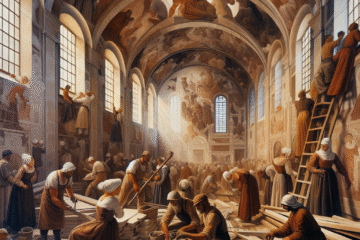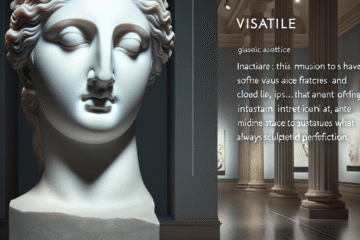I. Introduction
Egyptian art is one of the most recognizable and enduring art styles in history. Its influence can be seen in the works of countless artists and in various forms of popular culture. The art of ancient Egypt is significant not only for its aesthetic beauty but also for the cultural and historical information it provides. In this article, we will explore the historical significance of Egyptian art and provide some context for understanding the timeline and major periods of this art style.
Egyptian art dates back to the Prehistoric period, which spans from the Neolithic era (ca. 6000 BCE) to the Early Dynastic Period (ca. 3150-2686 BCE). During this time, the earliest forms of Egyptian art emerged, such as rock carvings, pottery, and small sculptures. These artworks served a religious purpose, as they were often created to depict gods, goddesses, and mythological creatures.
The Old Kingdom period (2686-2181 BCE) marks the beginning of the true Egyptian civilization. It was during this time that monumental architecture, such as the pyramids, began to be constructed. Egyptian art during the Old Kingdom period was characterized by a strict adherence to established conventions, such as the use of frontal and profile views in depicting human figures. The artworks from this period often depicted the pharaohs and their divine connections, highlighting the important role of religion in ancient Egyptian society.
The Middle Kingdom period (2055-1650 BCE) saw significant changes in Egyptian art. During this time, the pharaohs adopted a more personal and accessible approach to their rule, which was reflected in the art of the period. Artworks became more naturalistic, and human figures were depicted with more emotion and individuality. The art of the Middle Kingdom period also reflected the changing political and social landscape of ancient Egypt, as artists began to include more depictions of daily life, including farming, hunting, and fishing.
The New Kingdom period (1550-1070 BCE) is often considered the Golden Age of Egyptian art. During this time, monumental architecture continued to be built, and tomb decoration became more elaborate. Artworks from the New Kingdom period often depicted the pharaohs and their queens in various poses, emphasizing their power and divinity. The art of this period also saw the emergence of new styles and techniques, such as the use of color and depth perception in painting.
The Late Period (664-332 BCE) marks the decline of ancient Egyptian civilization. During this time, Egypt was ruled by foreign powers, including the Persians and the Greeks. Egyptian art during the Late Period was characterized by a blending of Egyptian and foreign styles. The use of hieroglyphs and religious symbolism declined, and artworks became more simplistic and utilitarian in nature.
In conclusion, the art of ancient Egypt is significant for its cultural and historical value. Through its various styles and periods, Egyptian art provides us with a window into the beliefs, customs, and everyday life of one of the most influential civilizations in history. From the strict conventions of the Old Kingdom period to the naturalistic and emotionally expressive artworks of the Middle Kingdom, the evolution of Egyptian art is a testament to the creativity and ingenuity of its artists.
II. Old Kingdom Period (2686-2181 BCE)
The Old Kingdom period (2686-2181 BCE) is an important period in the history of ancient Egypt. During this time, the pharaohs of the fourth through sixth dynasties commissioned great works of art and architecture, many of which still survive today. In this article, we will explore the characteristics and themes of art from the Old Kingdom period, as well as the cultural and religious significance of this art.
Characteristics and Themes of Old Kingdom Art
Old Kingdom art is characterized by a strict adherence to established conventions. Human figures were depicted with a combination of frontal and profile views, resulting in a stylized, flat appearance. Men were often depicted with reddish-brown skin, while women were depicted with yellow skin. The figures were typically static, with their arms held close to their bodies and their hands clenched into fists.
The most common themes in Old Kingdom art were religious in nature. Pharaohs were depicted as god-like figures, often shown performing rituals or making offerings to the gods. Other popular subjects included scenes from the afterlife, such as the weighing of the heart ceremony, and scenes from daily life, such as hunting and farming.
Cultural and Religious Significance of Old Kingdom Art
Egyptian art during the Old Kingdom period was closely tied to the culture and religion of ancient Egypt. The pharaohs were considered to be divine rulers, and their artworks were designed to emphasize their power and connection to the gods. Artworks such as statues and reliefs were created to provide a physical representation of the pharaoh, which would serve as a focus for the rituals and offerings made to him.
In addition to their religious significance, Old Kingdom artworks also had cultural significance. The construction of monumental architecture such as pyramids and temples required a significant amount of resources and labor. This required a highly organized and centralized government, which in turn helped to maintain social order and stability.
Notable Artworks from the Old Kingdom Period
The Pyramid Texts are among the most notable artworks from the Old Kingdom period. These texts were inscribed on the walls of the burial chambers of pharaohs and provided a guidebook for the afterlife. The texts were intended to help the pharaohs navigate the dangers and challenges of the underworld, and included spells and incantations to ward off evil spirits.
Another notable artwork from the Old Kingdom period is the Great Sphinx. This monumental sculpture stands 20 meters tall and depicts a mythical creature with the body of a lion and the head of a human. The Great Sphinx was built during the reign of Pharaoh Khafre and is thought to have served as a guardian of his tomb.
Conclusion
The Old Kingdom period was a significant time in the history of ancient Egypt, and its art provides valuable insight into the culture and religion of the time. Old Kingdom art is characterized by its strict adherence to established conventions, its religious themes, and its emphasis on the power and divinity of the pharaohs. Notable artworks from this period include the Pyramid Texts and the Great Sphinx, both of which continue to fascinate and inspire people today.
III. Middle Kingdom Period (2055-1650 BCE)
The Middle Kingdom period (2055-1650 BCE) was a time of great change and development in the history of ancient Egypt. During this period, the pharaohs of the eleventh and twelfth dynasties implemented significant social and political reforms, and these changes were reflected in the art of the time. In this article, we will explore the changes and developments in Egyptian art during the Middle Kingdom period, as well as the social and political context that influenced this art.
Changes and Developments in Middle Kingdom Art
One of the most notable changes in Middle Kingdom art was the shift towards more naturalistic depictions of human figures. Rather than the stylized, flat appearance of Old Kingdom art, Middle Kingdom figures were shown with more individuality and emotion. Figures were often depicted in a variety of poses and with more attention to detail, including musculature and facial features.
Another significant development in Middle Kingdom art was the inclusion of scenes from daily life. Artworks from this period often depicted activities such as farming, hunting, and fishing, as well as scenes from urban life. This reflected a growing interest in the lives of ordinary people and a desire to celebrate the achievements of the pharaohs in improving the welfare of their subjects.
Art Reflecting Social and Political Changes
Middle Kingdom art was closely tied to the social and political changes that took place during this period. The pharaohs of the Middle Kingdom sought to create a more personal and accessible style of rule, which was reflected in their artworks. Rather than being depicted solely as god-like figures, Middle Kingdom pharaohs were often shown in intimate settings, such as playing with their children or participating in everyday activities.
Another significant change in Middle Kingdom art was the increasing prominence of women in artworks. Women were often shown as equal partners to men, and were depicted in various roles such as priests, musicians, and scribes. This reflected a shift in attitudes towards women, as they gained greater independence and social status.
Notable Artworks from the Middle Kingdom Period
The Narmer Palette is one of the most notable artworks from the Middle Kingdom period. This ceremonial palette, which dates to around 3100 BCE, depicts the unification of Upper and Lower Egypt under the first pharaoh, Narmer. The palette is decorated with intricate carvings and is thought to have been used in religious ceremonies.
Another notable artwork from the Middle Kingdom period is the tomb of Mentuhotep II. This tomb, which dates to around 2000 BCE, is one of the largest and most elaborate in the history of ancient Egypt. The tomb is decorated with intricate carvings and reliefs, and includes scenes from daily life as well as depictions of the pharaoh and his gods.
Conclusion
The Middle Kingdom period was a time of significant change and development in the history of ancient Egypt, and its art reflects this. Middle Kingdom art saw a shift towards more naturalistic depictions of human figures, as well as an increasing focus on scenes from daily life. Artworks from this period also reflected the social and political changes taking place, with greater emphasis on personal rule and the inclusion of women in artworks. Notable artworks from this period include the Narmer Palette and the tomb of Mentuhotep II, both of which demonstrate the artistic achievements of this period.
IV. New Kingdom Period (1550-1070 BCE)
The New Kingdom period (1550-1070 BCE) is often considered the Golden Age of Egyptian art. During this time, the pharaohs of the eighteenth, nineteenth, and twentieth dynasties commissioned great works of art and architecture, many of which still survive today. In this article, we will explore the Golden Age of Egyptian art during the New Kingdom period, as well as the cultural and religious significance of this art.
The Golden Age of Egyptian Art
The New Kingdom period saw a great flourishing of art and architecture in ancient Egypt. Monumental architecture such as temples and tombs were constructed on a grand scale, and artworks were created with great skill and attention to detail. Artists during this period experimented with new styles and techniques, such as the use of color and depth perception in painting.
One of the most notable features of New Kingdom art was its emphasis on the pharaohs and their queens. These figures were depicted in various poses, emphasizing their power and divinity. Artworks from this period also reflected the religious beliefs of the time, with scenes from the afterlife and depictions of the gods and goddesses.
Cultural and Religious Significance of New Kingdom Art
New Kingdom art was closely tied to the culture and religion of ancient Egypt. Artworks were often created to serve a religious or funerary purpose. The pharaohs believed that they would be judged in the afterlife based on their deeds in life, and therefore commissioned elaborate tombs and funerary objects to ensure a successful journey to the afterlife.
In addition to their religious significance, New Kingdom artworks also had cultural significance. The construction of monumental architecture and the creation of great works of art required a significant amount of resources and labor, and these projects helped to maintain the pharaohs’ power and prestige. Artworks were also used to communicate messages of strength and stability to other nations, as well as to provide a focus for the rituals and offerings made to the gods.
Notable Artworks from the New Kingdom Period
The Great Temple of Amun at Karnak is one of the most notable artworks from the New Kingdom period. This vast temple complex was constructed over several centuries and covers an area of over 100 hectares. The temple is decorated with intricate carvings and reliefs, depicting scenes from daily life as well as the pharaohs and the gods.
Another notable artwork from the New Kingdom period is the tomb of Tutankhamun. This tomb, which was discovered in 1922, contained a vast array of treasures and funerary objects, including the famous golden mask of Tutankhamun. The tomb provides a fascinating glimpse into the beliefs and customs surrounding death and the afterlife in ancient Egypt.
Conclusion
The New Kingdom period was a time of great artistic achievement and cultural significance in the history of ancient Egypt. The Golden Age of Egyptian art during this period saw the creation of some of the most impressive works of art and architecture in the world. These artworks were closely tied to the culture and religion of ancient Egypt, and provided valuable insight into the beliefs and customs of the time. Notable artworks from this period include the Great Temple of Amun at Karnak and the tomb of Tutankhamun, both of which continue to fascinate and inspire people today.
V. Late Period (664-332 BCE)
The Late Period (664-332 BCE) marks the decline of ancient Egyptian civilization. During this time, Egypt was ruled by a series of foreign powers, including the Persians and the Greeks. The art of the Late Period reflects these changes, with a blending of Egyptian and foreign styles, and a shift towards more simplistic and utilitarian art. In this article, we will explore the decline of Egyptian art during the Late Period, as well as its legacy and notable artworks from this period.
Decline of Egyptian Art during the Late Period
The Late Period saw a decline in the quality and quantity of Egyptian art. The influence of foreign powers, particularly the Greeks, led to a blending of Egyptian and foreign styles. Artworks from this period often feature Greek motifs and styles, such as the use of naturalistic forms and perspective in painting.
Another significant shift in Late Period art was the move towards more simplistic and utilitarian styles. Artworks became more functional in nature, serving a practical purpose rather than a religious or cultural one. This reflected the decline of the centralized government and the loss of the resources needed to support grand artistic projects.
Legacy of Egyptian Art
Despite the decline of Egyptian art during the Late Period, its legacy has continued to influence Western art and culture. Egyptian art has been a source of inspiration for artists throughout history, from the Greek and Roman periods to the present day. Egyptian motifs and styles can be seen in everything from Art Deco design to contemporary street art.
Egyptian art has also had a significant impact on Western culture. The discovery of ancient Egyptian artifacts in the 19th century sparked a craze for all things Egyptian, known as Egyptomania. This fascination with ancient Egypt is still evident in popular culture today, with references to Egyptian mythology and motifs in movies, books, and television shows.
Notable Artworks from the Late Period
The Rosetta Stone is one of the most notable artworks from the Late Period. This stone, which was discovered in 1799, contains a decree issued by Ptolemy V in 196 BCE. The decree is inscribed in three scripts: hieroglyphs, demotic script, and ancient Greek. The Rosetta Stone played a key role in deciphering hieroglyphs and unlocking the secrets of ancient Egyptian civilization.
Another notable artwork from the Late Period is the Temple of Isis at Philae. This temple, which was constructed between the 4th century BCE and the 3rd century CE, is a masterpiece of Late Period architecture. The temple is decorated with intricate carvings and reliefs, depicting scenes from Egyptian and Greek mythology.
Conclusion
The Late Period marks the decline of ancient Egyptian civilization, and its art reflects these changes. The influence of foreign powers and the shift towards more simplistic styles led to a decline in the quality and quantity of Egyptian art. Despite this, the legacy of Egyptian art has continued to influence Western art and culture. Notable artworks from this period include the Rosetta Stone and the Temple of Isis at Philae, both of which demonstrate the artistic achievements of the Late Period.
VI. Conclusion
Throughout this article, we have explored the rich and complex history of Egyptian art, spanning several millennia and encompassing a wide range of styles and techniques. We have discussed the key characteristics and themes of art from the Old Kingdom, Middle Kingdom, New Kingdom, and Late Period, as well as the cultural and religious significance of these artworks.
In the Old Kingdom, we saw the emphasis on established conventions and religious themes, as well as the importance of the pharaohs as god-like figures. The Middle Kingdom saw a shift towards more naturalistic depictions of human figures and an increasing focus on scenes from daily life. The New Kingdom marked the Golden Age of Egyptian art, characterized by monumental architecture, intricate carvings, and religious themes. The Late Period, however, saw a decline in the quality and quantity of Egyptian art, with a shift towards more simplistic and utilitarian styles.
Despite the decline of Egyptian art during the Late Period, its legacy has continued to influence Western art and culture. Egyptian art has been a source of inspiration for artists throughout history, and its motifs and styles can be seen in everything from Art Deco design to contemporary street art. Egyptian art has also had a significant impact on Western culture, sparking a fascination with ancient Egypt that continues to this day.
In conclusion, Egyptian art is a vital part of the history and culture of ancient Egypt. Its enduring legacy in art history is a testament to the skill and creativity of the artists who created these magnificent artworks. The themes and techniques of Egyptian art continue to inspire artists and fascinate people around the world, providing a glimpse into the rich and complex history of this ancient civilization.


